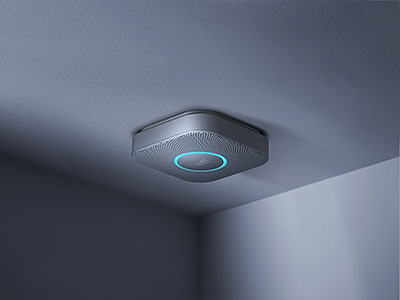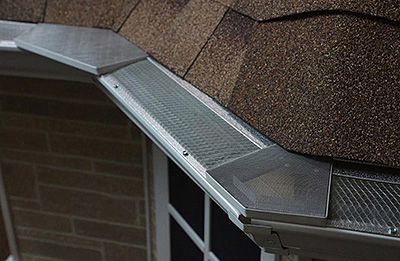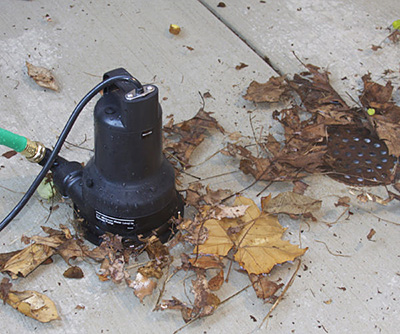Stay Up to Date with Periodic Home Maintenance
by Eric Amos, Product Editor and Writer
A precious few homeowners actually enjoy maintaining their houses, so many people simply don’t schedule the time for routine maintenance. Whether you like it or not, it’s important to know that various parts of your home need to be checked, cleaned, and maybe replaced every so often. All of this is to your benefit; it creates a safer and more comfortable environment to call home and preserves your property value. Here are some of the areas you should address regularly to make sure your house is kept in good working order.
Smoke and Carbon Monoxide Detectors
It should be a priority, but the reality is that most people don’t check their smoke or carbon monoxide detectors without some kind of wakeup call and they are shocked to learn how often they should do it. The United States Fire Administration (USFA) recommends that alarms are tested every month, and that batteries are swapped every six months. Be sure to wear hearing protection when you press the test button, and reset and retest whenever the batteries are changed. It’s important to do this for every smoke detector in the house at the same time so you know the status of each one and address it in due time, because you never know when or which one will save somebody’s life.
Some detectors are sealed with long-lasting batteries, and others are hardwired into the home’s electrical system with backup batteries so they still work in power outages. These might give you greater peace of mind, but they should still be tested monthly. Sometimes batteries don’t last as long as advertised, and malfunctions are always a possibility with technology. So, stay on top of testing your alarms—the safety of your family is worth the time.
HVAC Filters
Somewhere in your home, a disposable HVAC filter is waiting to be changed. It probably doesn’t make the top of your list of concerns, but having a clean filter keeps your furnace or combined HVAC systems performing well by preventing dust and other particles from causing a blockage that impedes home air circulation. If the filter does its job and captures particles before they can cause a problem, it becomes a source of reduced flow itself, so be sure to have replacements handy. You should become familiar with your HVAC filter needs over time—sometimes it only needs to be changed every three months, but once a month is recommended if you have a large family, pets, or people with allergies in the house, or live in an area with agriculture, high winds, or construction nearby.
Failure to change the HVAC filter often enough can cause health problems, lead to costly repairs or replacement, and be a source of inefficiency that leads to higher utility bills. It only takes a few minutes to improve home air circulation, and performing this simple task can alert you to big problems that you’ll be glad to catch early. For example, if the filter is damp, you should call a technician to help identify and stem the source of the moisture before your HVAC system becomes a vehicle for the dispersal of mold spores.
Furnace and Air Conditioner
Of course, filters can’t do everything, and your HVAC systems themselves should be vetted to keep them working well. Barring any strange noises, obvious breakdowns, or other concerns, plan to have a professional come to service your furnace and central air conditioner once per year. It’s recommended to do this the season before you’ll be relying on them—so schedule your furnace for a checkup in autumn and your air conditioner for one in spring. The cost is usually very reasonable, and it can prolong the life of your appliances and prevent malfunctions from occurring at the worst times.
Range Hood Filters
The fan and filter above the stove draw steam, smoke, and grease up and away as you cook, and many people just forget about them. But filters get filthy as they trap particles that would otherwise settle on walls and furniture, and you don’t want to leave that alone. Not only is it unsightly, but all that grease is a fire hazard. Make a habit of cleaning the filter every month to stay on top of the buildup. Simply remove the filter from the hood and decide on your method of choice—you can use hot water, soak and scrub with natural cleaners like vinegar and baking soda, or employ a heavy-duty degreaser to strip the grime off. Range hood filters can last for years with good care, but replacements are inexpensive if yours is a lost cause.
Gutters
By the time you notice your gutters are blocked, you’ve already put your home at risk. Experts recommend cleaning out your gutters at least twice per year, in spring and autumn, to stay ahead of leaf litter buildup. If your home is surrounded by pine trees, you should do it at least four times per year. With a ladder, some gloves, and a hose, it shouldn’t take you very long, but there are professional cleaning services if you don’t want to tackle the task yourself.
Clean gutters help to protect your entire home from the ground up. They direct rainwater away from the foundation, and that prevents waterlogged soil from putting pressure on the structure on which your house is built. When gutters are clogged, water instead cascades down the sides of the house, which can damage siding and deposits all that moisture right where you don’t want it. Sometimes, a backlog forces water inside, where it will cause mold growth. And if you live in a place that freezes, ice can cause damage to edges of the roof. Of course, you can invest in gutters designed to keep debris out, but they should still be checked—you never know when a small animal might think they’re a great place to make a nest!
Dryer Vent
The dryer should be shut off and disconnected at least once per year—and more often for larger families who have a lot of laundry—to clean out the hose and dryer vent, which become coated with lint and are a fire hazard when blocked. You can stand near the exhaust vent outside to get a feel for how congested yours is when you dry a load; it should blow plenty of warm air that smells like clean laundry, and in the winter, it could even release steam. If your clothes take a long time to dry, the dryer gets very hot, or you can see lint blocking the vent flap, it’s time to clean. Regular maintenance will keep the dryer running efficiently and save time and money, though, so don’t wait for warning signs. Many homeowners can clean the vent themselves, but a professional likely has the tools and know-how to do it more effectively.
Sump Pump
Mother Nature can make your basement flood even if you do everything in your power to prevent it, so make sure your sump pump is actually functional. In areas with a high water table, you’re probably already familiar with your pump and might be able to hear it every so often, and that’s good. If you’ve never heard the motor run, you should check it at least once per year or before a serious storm to ensure that it’s ready to do its job. It’s as simple as giving it something to do—slowly pour a big bucket of water into the system until the float activates to pump it out, and then it should shut off when the float drops. Be sure to check the discharge pipe, too; it should lead away from the house, preferably down a grade, or else water could just seep in again.
Water Heater
You can prolong the life of your water heater by flushing it out every year. Over time, sediments and mineral buildup get trapped in the tanks of traditional models and the pipes of tankless ones, and heaters lose efficiency as a result. This is an especially common occurrence in areas with hard water, so take that into account when determining how often it should be done. The procedures for safely flushing a water heater are fairly long and complicated, so it’s better to call in a contractor to do it for you. You’ll immediately notice how much faster your water heats up after a flush, and it will save you at least as much money as its costs.
Although this list is by no means exhaustive, it does cover a lot of the areas where homeowners tend to get complacent. Regularly maintaining your home keeps it in good condition, identifies issues before they become problems, reduces utility costs, and might even save your life, so don’t shirk the regular duties that come with ownership. You might even discover a task that you enjoy! Of course, you can always browse our house plans to find your ideal dream home that you won't mind performing routine maintenance on, if you need a little more motivation!
BROWSE HOME PRODUCT ARTICLES
- Creating a Spa-Like Master Bathroom »
- Designing a Water-Efficient Bathroom »
- Design a Modern Bathroom »
- View All Bathroom Articles »
- Building a New Home »
- Building a Duplex »
- Finding the Right Home Builder »
- View All Building Tips Articles »
- Adding the Right Columns»
- Decorative Touches for Your Interior»
- Shutters for Every Architectural Style »
- View All Columns & Millwork Articles »
- How to Use Specialty Laminates »
- Decorative Touches for Your Home's Interior
- View All Countertops and Surfaces Articles »
- What Goes Into a Great Deck? »
- Decorative Touches for Your Home's Interior »
- View All Decking Articles »
- Choosing Glass for Your Entry »
- Stylish Personas for Your Front Door »
- Using Sidelites and Transoms »
- View All Door Articles »
- Choose Siding for Your Region »
- Get the Most Out of Exterior Paint »
- Mixing Siding to Define Your Exterior »
- View All Exterior Articles »
- Finding the Right Home Builder »
- The Appeal of Small House Plans »
- Choosing the Perfect Floor Plan »
- View All Finding a Home Plan Articles »
- Colorful Flooring for Your Home »
- Designing With Different Widths»
- Chic, Neutral, Gray Flooring »
- View All Flooring Articles »
- Garage Doors That Add Curb Appeal »
- Caring for Your Garage Doors »
- Benefits of Insulated Garage Doors »
- View All Garage Door Articles »
- Reclaimed Products for Your Home »
- Building a Green and Stylish Home »
- Benefits of Building with SIPS »
- View All Green Building Articles »
- Cool Gadgets for Your New Home »
- Creating a Hi-Tech Home »
- Efficient Gifts for New Homeowners »
- View All Home Electronics Articles »
- Improve Your Home's Air Circulation »
- How to Improve the Air Circulation in Your Home »
- View All HVAC Articles »
- Bedrooms Designed for Sleep »
- Selecting a Fireplace for Your Home »
- Crafting a Luxurious Master Suite »
- View All Interior Design Articles »
- Design the Perfect Outdoor Space »
- Dive into a Beautiful Pool »
- Design a Sizzling Outdoor Kitchen »
- View All Outdoor Living Articles »
- Apps to Help You Pick Paint Colors »
- Create the Perfect Mood with Paint »
- How to Read the Color Wheel »
- View All Painting & Decorating Articles»
- Creating a Spa-Like Master Bathroom »
- High-Impact Kitchen Upgrades »
- Creating a Water Efficient Bathroom »
- View All Plumbing Fixtures Articles»
- Cladding That Complements Your Exterior »
- Reasons to Consider Prefinished Siding »
- View All Siding & Cladding Articles»
- All About Solar Powered Skylights »
- Natural Lighting for the Dark Corners of Your Home »
- Design a Better Bedroom with Skylights »
- View All Skylight Articles»
.png)
.png)



